A House Built 9,000 ft Above the Ground Leaves Authorities With Many Questions and Concerns
If you find yourself in the Dolomites region in Italy, we suggest you look up–way up. Of course, it’s impossible to see from the ground, but if you could see 9,000 feet up, you might spot a peculiar little hut on the side of a mountain. And you might wonder to yourself, how did it get there?
The effort required to reach this isolated home is great, but the reward of picturesque solitude is even greater.
A Mountain Mystery
A cliffside dwelling a thousand feet from the ground is a real head-scratcher. Imagine seeing such a sight and thinking–we should build another. Well, that’s the exact thought the team from the architectural firm Studio Demogo had! Their recent construction of a second mysterious mountain hut was a bold and wild endeavor.

Source: Soccorso Alpino e Speleologico Veneto - CNSAS/Facebook
The daring team saw a need for a shelter structure in the area. They completed its construction in 2021–despite the extreme difficulties and challenges posed by the location. Knowing the struggles encountered in 2021, the achievement of building the first hut, the Buffa di Perrero, several decades earlier is even more impressive.
Modernizing
The new shelter structure, dubbed the Bivouac Fanton, is a remarkable feat. Situated along the Dolomites’ Marmarole trail at a staggering 8,750 feet above sea level, it is nearly as high up as the iconic hut, the Buffa di Perrero, which stands roughly 250 feet higher.

Source: reverie.studiomu/Instagram
Despite advancements in 21st-century technology and the additional advantage of a lower altitude, the construction of Bivouac Fanton was a challenging and labor-intensive process. The team overcame numerous obstacles and pushed the limits of what was thought possible to erect the modern hut.
New Hiking Refuge
The Bivouac Fanton was designed with the needs of hikers and climbers in mind, providing much-needed accommodation for those trekking the route to the tallest peak in the region. But the construction process was not without hardships, and the team at Studio Demogo faced challenges in transporting building materials to the site.
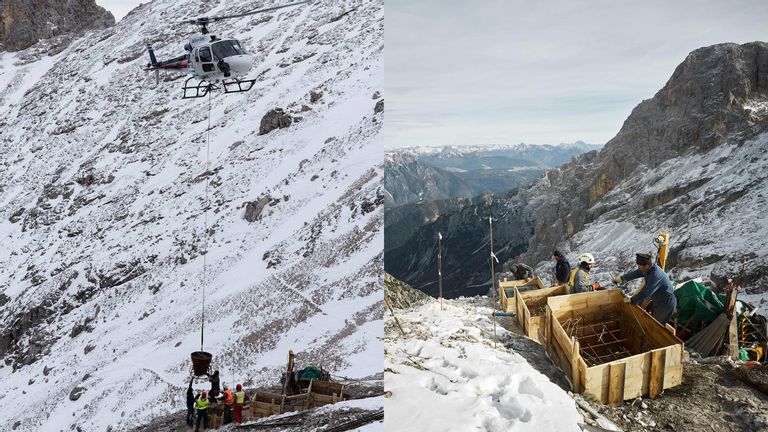
Source: DEMOGO/Facebook|DEMOGO/Facebook
In total, it took three attempts by helicopter to carry materials to the remote location safely. However, the high altitude wasn’t the only obstacle–the surrounding area also presented its own problems.
The Weather Calls for Trouble
Plans for delivering building materials to Bivouac Fanton by helicopter were hindered by inclement weather. Though waiting for favorable conditions did add some delay, it was still a faster option than other alternative means of transportation.

Source: DEMOGO/Facebook
Even with a ski lift to cover part of the journey, it takes an experienced hiker five hours to hike to the shelter’s location–unencumbered by materials, that is. It’s worth noting that during the construction of the first hut, the Buffa di Perrero, the option of using helicopters was not present.
Getting There on Foot
Reaching the Buffa di Perrero requires significant effort–even for well-equipped modern-day hikers and climbers. Visitors to Buffa di Perrero do not have the option of taking a gondola to ease the strain of their expedition.

Source: DEMOGO/Facebook
In fact, the arduous ascent up to this stunning spot today is similar to what it would have been during the hut’s construction, making it a true test of endurance and determination for those who are brave and willing enough to undertake it.
Experience Required
Without a gondola at your disposal, visiting Buffa di Perrero is a formidable pursuit that requires a dedicated and considerable amount of time–at least an entire day. Therefore, it is a path that hikers should only attempt if they possess a high level of experience and fitness due to the demanding nature of the journey, including the utter scale of the path.

Source: astartesyriaca81/Instagram
So the mystery that surrounds the Buffa di Perrero only adds to the allure and appeal of the place for the adventurous sort.
The Iron Path
Buffa di Perrero is situated along the via ferrata Ivano Dibona, which can be translated to roughly mean “Iron Path” in English. What an apt description for this taxing and treacherous route!

Source: Carolco Pictures
Despite its grueling nature, the Ivano Dibona gained fame as the location of a 90s blockbuster movie starring the heroic Sylvester Stallone. And it was no easy feat to produce the film–that’s a given. Nevertheless, the site provided a scenic but burdensome setting for the film crew.
Hollywood Backdrop
The film in question is none other than Cliffhanger, starring Sylvester Stallone. Many of the action sequences were filmed along Ivano Dibona. For example, the iconic scene of the anxiety-inducing bridge explosion. Though the film didn’t receive great reviews at the time of release, many viewers do agree that the action scenes were intense and visually spectacular.

Source: Carolco Pictures
And despite the movie’s hefty $60 million budget, the production team faced many difficulties in shooting along this challenging and frightening mountain range, not least because the lead actor himself had a fear of heights!
Mountain vs. Movie
The filmmakers made sure to take all necessary safety precautions while filming along the Ivano Dibona, but the location’s nature presented its challenges. Shooting at elevations that reached 13,000 feet meant that even a minor change in weather conditions could force production to halt filming.

Source: Carolco Pictures
This further proves how challenging and unlikely building the Buffa di Perrero was. The logistics of accessing and constructing the structure in such a remote and harsh place would be tricky even today, let alone several decades ago.
Who’s up for a Challenge?
Accessing the Ivano Dibona is even harder for those without the benefit of a $60 million budget. Modern-day hikers begin their ascent using a chairlift, but it only takes them to the base of a now-defunct gondola ride. From there, they face the daunting task of a steep climb uphill for 2,300 feet–a real test of endurance.

Source: Timo Waltari/Flickr|CC BY-SA 2.0
The complete lack of conveniences makes the mountain’s ascent barely accessible to most people. This is not a journey for the faint of heart by any means.
An Arduous Journey
Realistically, even reaching the start of the Ivano Dibona trail takes a considerable amount of effort. Hikers must trek for approximately two hours before they even reach the beginning of the trail! Of course, once they reach the starting point, there are still more obstacles to overcome.

Source: Timo Waltari/Flickr|CC BY-SA 2.0
This includes crossing shaky, dilapidated metal stairs–plus a ladder. So arriving at the iconic bridge that was featured in the movie Cliffhanger is no walk in the park. But all these challenges make the hike rewarding as they test the stamina and determination of those who seek it.
On the Way Up
Now, assuming hikers can conquer the metal stairs, ladder, and several short tunnels, they will finally find themselves at the Cliffhanger bridge. There, they can take a moment to rest and recover while taking in the stunning views. And maybe have a bit of fun by reenacting their favorite scene from the movie.

Source: Carolco Pictures
But the journey is far from over. There is still a considerable distance to go before they reach the storied Buffa di Perrero. Moreover, challenges still await on the trail ahead–challenges that are physical and also mental.
What Goes up Must Come Down
Hikers can count themselves lucky they are not burdened with the added weight of carrying building supplies. It makes it much more manageable to hike to Buffa di Perrero without it, which becomes all the more evident as they begin their descent through the Dolomites.

Source: Timo Waltari/Flickr|CC BY-SA 2.0
The hike down the mountain to reach the mysterious hut is not trouble-free and requires good fitness and experience. The downward trail boasts steep inclines and rough terrain. After all, the trail earned its name as the “Iron Path” for a reason–it merits the label.
Hang On Tight
The first step in the final push towards Buffa di Perrero is to climb a ladder to a small peak and then start trekking along the ridgeline. Hikers must closely follow the cables that extend along the route.

Source: Roberto Povoleri/Facebook
The wires serve an essential purpose and are not merely for decoration. Instead, they provide support and safety for anyone attempting to hike the trail. They help hikers navigate the unforgiving terrain and give a sense of security during their journey. Therefore, it’s vital to keep close.
Mystery Hut Emerges
After that long journey, travelers will finally catch a glimpse of Buffa di Perrero. At this point, the adventure will have taken them as long as four hours of hiking, traversing through tunnels, climbing ladders, crossing a perilous bridge, and descending a steep trail.

Source: Mariusz Z/Flickr|CC BY-SA 2.0
This unusual and remote mountain hut is not easy to access, so it’s no surprise at all that many people have been left bewildered by this mysterious little hut–it’s a strange sight to behold!
At First Sight
The initial sight of Buffa di Perrero might be quite unexpected for visitors, who may be surprised to see a small and picturesque home after hours of navigating the mountain terrain. The hut itself is unusual, as it seems as though it has been carved directly into the face of the cliff, almost giving the impression that the mountain grew around it.

Source: Raixe Venete/Facebook
This architectural feature adds to the mysterious aura of the little hut. It can be quite a striking sight, even making those who cross its path question if they are still on the same trail they have been on for hours.
Hut Inspection
The unique and unusual structure of Buffa di Perrero is sure to pique visitors’ curiosity, with many feeling compelled to take a closer look and examine the hut in detail. It is clear that the hut is quite old, making it hard to comprehend that it could have been built all those years ago without modern technology–simply remarkable!
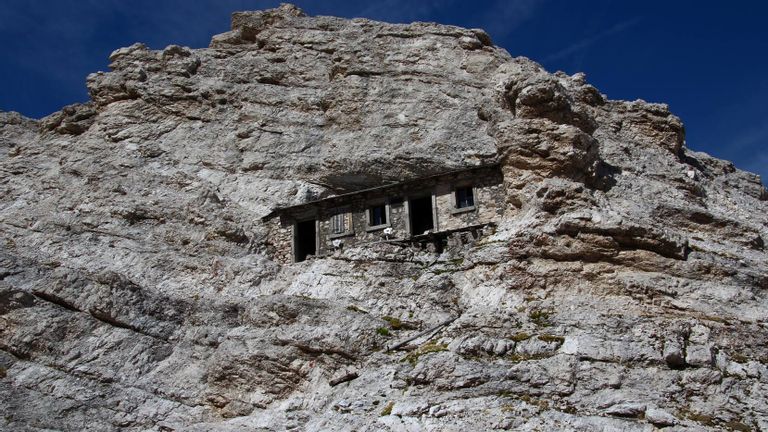
Source: Roberto Povoleri/Facebook
Nevertheless, someone or a group managed to transport building materials and construct it. A testament to human ingenuity and determination, it’s plain to see why it leaves many visitors in awe.
Mountain Materials
The exterior walls of Buffa di Perrero appear to be made of stone, which blends seamlessly with the surrounding rocks of the mountain–like a natural camouflage. It’s possible these stones were sourced from the mountain, which makes sense.

Source: Raixe Venete/Facebook
However, the wooden interior, framed windows, and chairs are not easily explainable. These materials were most likely brought up to the location from elsewhere, which raises the question of the logistics of building such a structure in such a remote location.
A Treacherous Hideaway
The roof of the Buffa di Perrero is also exceptional. It appears to have been fabricated from a combination of wood and stone. The creator of the hut clearly put a lot of time, effort, and resources into making it a secure and safe hideaway in the hills.
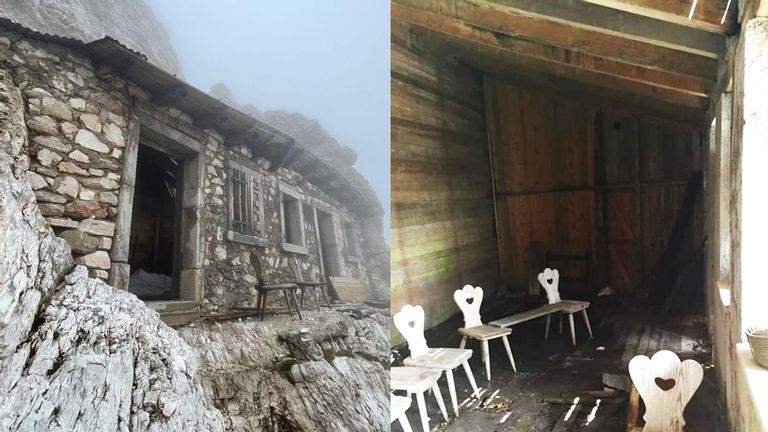
Source: Soccorso Alpino e Speleologico Veneto - CNSAS/Facebook|Raixe Venete/Facebook
However, despite its solid construction, the mountain environment is unpredictable and unforgiving and can change rapidly. This was the case in the summer of 2021 when the mountain proved its might, and Buffa di Perrero was hit with an unexpected event.
Trouble Looms
By now, we know the weather conditions in the Dolomites can be very challenging, causing difficulties even for trained crews and movie productions. Therefore, it is not surprising that the same forces of nature that stalled other operations would also affect Buffa di Perrero.

Source: Marco Maman/Facebook
The 2021 incident serves as a reminder of the destructive power of wind and snow in the Dolomites and that even the most secure and well-built structures are not immune to the harsh mountain environment. The Buffa di Perrero became another victim of the Dolomites’ unpredictable and often relentless weather conditions.
Collapse
When inclement weather hit the mountain range, a tragic collapse occurred at Buffa di Perrero. The roof buckled under the pressure and the interior wooden beams supporting it broke and bent. As seen in the images shared by an Alpine rescue organization, substantial internal damage took place.

Source: Soccorso Alpino e Speleologico Veneto - CNSAS/Facebook
The structural damage was serious enough that the organization issued a warning to hikers to avoid the area. Without investigating thoroughly and assessing the total damage, the integrity of the structure was unknown and likely dangerous.
Do Not Enter
The Alpine rescue organization advised mountain goers to refrain from entering Buffa di Perrero due to potential hazards such as sharp wooden debris, among other risks. In spite of this warning, it’s highly likely some curious thrill seekers may still be interested in approaching the collapsed structure.

Source: Soccorso Alpino e Speleologico Veneto - CNSAS/Facebook
After all, it is not every day that you come across a mysteriously abandoned mountain hut. Therefore, it’s somewhat understandable that some individuals may want to see it closer–though certainly not advised.
A Curious Novelty
In the past, hikers could stop and stay at Buffa di Perrero when it served as a shelter. However, now that the structure has sadly collapsed, it has become more of an object of curiosity. People come to admire and appreciate it and see it as a place to take in beautiful views.

Source: Timo Waltari/Flickr|CC BY-SA 2.0
However, if people explore the damaged hut, they may also contemplate how the structure could have come to exist in the first place. How was it built?
The Battlefront
An in-depth examination of history may provide valuable insights. The Dolomites, which includes the Buffa di Perrero hut, is known for much more than simply being the setting of a Sylvester Stallone film.
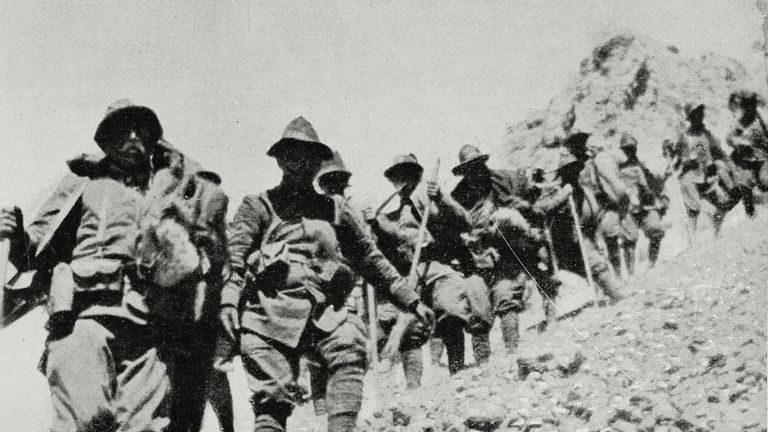
Source: DeAgostini/Getty Images
In fact, the Dolomites mountain range was the setting of one of the most devastating battles of World War I. The Dolomites will be forever etched in history as the brutal and unforgiving battleground it was–being the host to one of the most gruesome and prolonged battles of World War I.
Fighting in the Alps
The Dolomites region was the site of the so-called White War, a brutal battle between the Italian forces and their Austro-Hungarian counterparts. This conflict that took place between these wartime adversaries happened throughout the Alpine mountain range along the border, occurring in some of the most inhospitable conditions imaginable.

Source: DE AGOSTINI PICTURE LIBRARY/Getty Images
Troops fought at elevations as high as 12,000 feet and in temperatures as low as -22°F. These conditions made warfare even more challenging and dangerous for the soldiers, who had to not only face the enemy but also the extreme weather.
Soldiers on the Mountain
The mere notion of engaging in combat at such heights and in such harsh conditions is virtually unimaginable. Despite this, the men soldiered on for almost the entire duration of World War I, making the White War a historical event of courage, endurance, and sacrifice.

Source: DEA/ICAS94/Getty Images
Here we may gain a clue to the origins of the mysterious hut at Buffa di Perrero. Because the soldiers needed more than harsh language and gestures to survive and fight in these frigid environments–they needed specialized equipment. The Dolomites were to be a stage for some of the most significant innovations of the war.
Mountain vs. Man
A mountainous terrain is not conducive to combat warfare. Historically, the only individuals who ventured to the great heights of the Dolomites region were either foragers, shepherds, or mountaineers.

Source: DE AGOSTINI PICTURE LIBRARY/Getty Images
Since there was no mountain infrastructure to speak of, troops on both sides of the conflict were forced to create and maintain paths either through or over the mighty Dolomites. Suffice it to say the conflict forever altered the mountain’s landscape.
Tunneling Through
The Austro-Hungarian and Italian military forces were engaged in the toilsome task of altering the natural landscape of the pristine Alpine mountains. Such work involved cutting down the mountains’ peaks and excavating through rocky terrain. They also undertook the building of roads, laying cables, and even installing telephone lines.

Source: DeAgostini/Getty Images
Two primary objectives drove these efforts. The first was to enable soldiers to quickly and efficiently reach the front lines of battle. And the second objective was somewhat less obvious and apparent.
The High Life
The soldiers on the front lines were required to maintain their positions for prolonged periods of time during the war effort. Such permanency entailed the establishment of long-term outposts in the bitter mountain environment–places that could endure whatever weather conditions presented themselves.

Source: Leemage/Universal Images Group via Getty Images
Consequently, a significant amount of equipment was hauled up to the high-altitude locations to support the war effort and also to provide for the daily needs of the soldiers. An efficient logistics and supply chain system was needed to manage this task.
Going to Extremes
Perhaps the pinnacle of this method of Alpine existence was demonstrated in the Dolomite mountain range during the year 1916. The specific location was the Marmolada, the most prominent peak in the range. The Austro-Hungarian army had devised a plan to dig a tunnel through the glacier in order to approach their enemy’s position covertly.
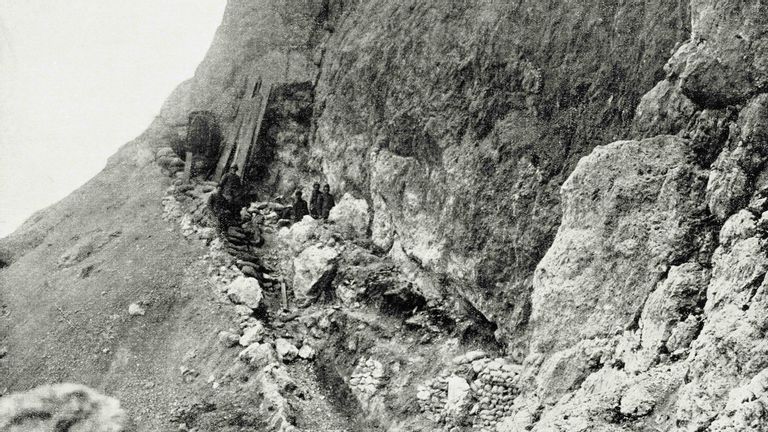
Source: DE AGOSTINI PICTURE LIBRARY/Getty Images
However, as the soldiers began their excavation, they ended up making a significant discovery they most certainly had not anticipated.
In or Out
At this point, the troops were well-acquainted with mountain warfare’s various dangers and challenges. They were familiar with the hazards of snowstorms, avalanches, and freezing temperatures that constantly threatened their survival. But while they were working inside the glacier, many of these concerns were less of an issue.

Source: Nardi Alberto/AGF/Universal Images Group via Getty Images
In fact, for many soldiers living inside the glacier, it was far preferable to the brutal conditions outside. They perhaps felt being inside the glacier provided a relative sense of safety and comfort compared to being exposed to nature’s elements.
Pressing On
As one development led to the next, soon, the Austro-Hungarian military forces were vigorously digging through the glacier. They were steadfast in their efforts, dedicating ten months to the excavation.

Source: K.u.k. Kriegspressequartier, Lichtbildstelle - Wien/Österreichische Nationalbibliothek - Austrian National Library/Europeana|Public Domain Mark 1.0
Ultimately, their labor resulted in creating a subterranean space large enough to sustain a population of 200 men. The result of their extraordinary undertaking was a network of tunnels that spanned over 7 miles, connecting the various positions of their troops. However, the tunnels were not the only thing that could be found inside the glacier.
Subterranean Ice Community
The area where these tunnels and underground compound were created has since been referred to as the “Ice City.” This underground compound was indeed an impressive achievement as it provided soldiers with a place to sleep, cook, and even practice their faith. Additionally, it had storerooms to keep food and supplies and sick bays to attend to any soldiers who were injured.

Source: Dolomites UNESCO/Facebook
The compound essentially contained everything needed to provide for the troops in their fight against the Italian forces. And the war did indeed extend to the specific sector of the Dolomites known as Buffa di Perrero.
Mountain Warfare
In the year 1915, an intense and unforgettable battle raged in the region surrounding Monte Cristallo–now the location of Buffa di Perrero. This conflict occurred during August and September. It was distinguished by the fact that a bombing campaign was launched directly on the mountain itself.
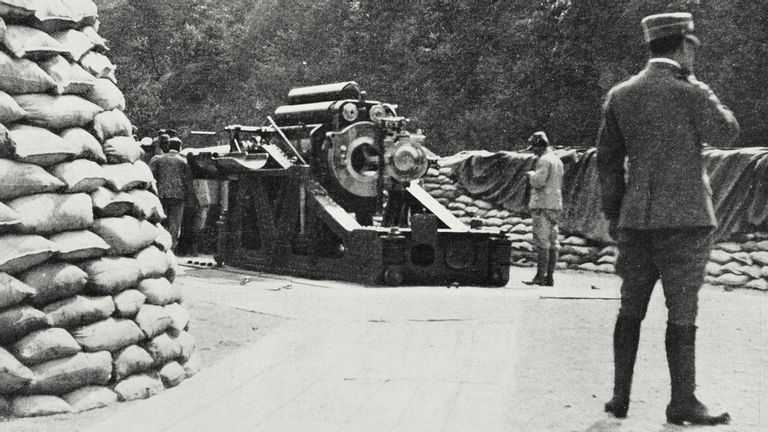
Source: DeAgostini/Getty Images
Incredibly, the troops had found a way to transport WWI-era artillery to their strategic positions and use them to fire upon the enemy. However, the battle was affected both by the troops’ actions and the unpredictable nature of the weather, which always played a crucial role in the area.
Push and Pull
The soldiers were constantly hampered during the fighting by the persistent mist, snow, and freezing temperatures that often plagued the area. As a result, when the battle was ultimately over, both sides had accomplished very little. A significant number of casualties had been sustained, and the destruction was widespread–all for the acquisition of only a handful of trenches.

Source: Imagno/Getty Images
However, despite the lack of significant territorial gains, this determined and brutal fighting style in the region may give way to some understanding of why Buffa di Perrero exists.
Could It Be..?
The Ivano Dibona trail was one of the key paths the Italian military forces utilized during World War I. Even today, hikers who traverse this via ferrata route have the opportunity to encounter remnants of the barriers and trenches constructed during the war.

Source: DE AGOSTINI PICTURE LIBRARY/Getty Images
Moreover, the very footholds used along the trail today are the same ones that the soldiers of the war used. Given this history, it can be inferred that the troops are likely the ones who built Buffa di Perrero.
No Solid Proof
It is worth noting that no concrete historical evidence regarding the soldiers constructing Buffa di Perrero confirms this is indeed the case. However, this is the generally accepted explanation among most historians.

Source: Fototeca Gilardi/Getty Images
Understandably, Buffa di Perrero would have been an ideal location for the soldiers, as it would have provided them with a strategic location for planning their subsequent maneuvers, storing supplies, or simply taking a break from the battlefield. Of course, it is no longer used for those purposes today.
Public Concern
When word got out regarding the extensive damage Buffa di Perroro suffered, the primary concern among many who posted on Facebook was if the shelter would be repaired. This location was a place of refuge for current hikers and an integral part of Italy’s historical heritage.

Source: Soccorso Alpino e Speleologico Veneto - CNSAS/Facebook|Soccorso Alpino e Speleologico Veneto - CNSAS/Facebook
Currently, there has yet to be an official announcement about any plan to restore Buffa di Perrero to its original state. Yet, despite the lack of information, the desire to preserve this important piece of Italy’s past is palpable.
What Remains to Be Found
The Dolomites mountain range in Italy is an example that highlights the fact that many historical artifacts remain hidden among the world’s mountains. The mountains have also revealed various artifacts and remains from World War I as the glaciers have begun to recede.
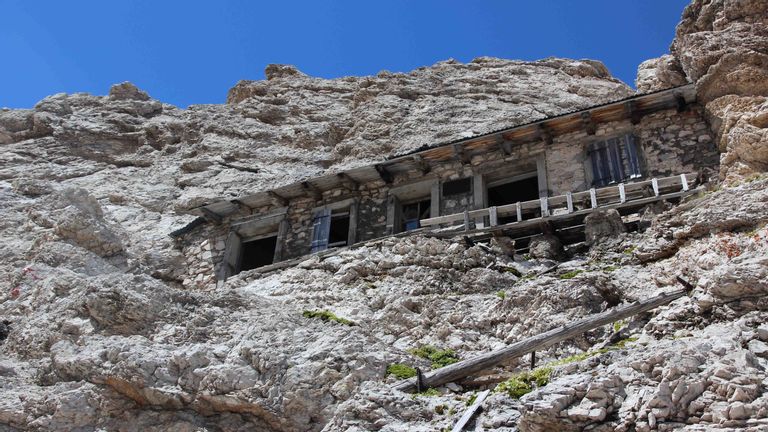
Source: Evelyne Chassagneux-Bonini/Wikimedia Commons|CC BY-SA 4.0
This discovery raises the question of what other untold stories may be hidden within different mountain ranges. It is not just the Dolomites that hold secrets of the past, but it’s a reminder that many more discoveries are out there waiting to be uncovered!
